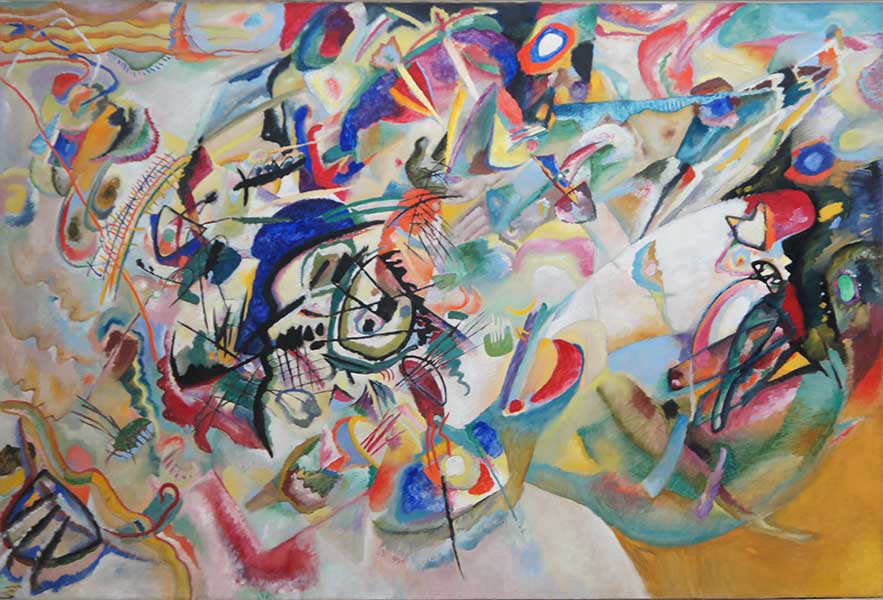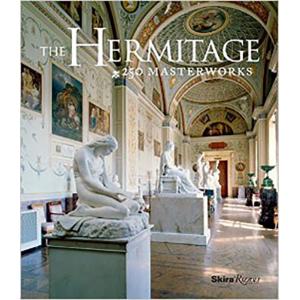The Collection of Twentieth Century Art at the State Hermitage Museum
by Cathy Locke

Claude Monet, "Lady in the Garden," 1867, Sergei Shchukin Collection, State Hermitage Museum, St. Petersburg
No one can ignore the Hermitage Museum’s impressive collection of impressionist and post-impressionist paintings. These paintings would never have become part of the collection if it were not for two titans of the art world, Sergei Shchukin and Ivan Morozov. Without these two collectors Russia would have never played such a crucial role in the history of twentieth-century art. They fell in love with art that the world at that time saw as ugly. Not only did they purchase large quantities of art, they built relationships with these artists and nourished their development.

Claude Monet, (right) "Pond at Montgeron," (left) "Corner of the Garden at Montgeron," 1876, Ivan Morozov Collection, State Hermitage Museum, St. Petersburg
By 1899 Sergei Shchukin was the first Russian collector of new French art. In 1898 he purchased a landscape by Monet entitled Rocks at Bellelle and Haystack at Giverny. He was beginning to understand the language of the new art. “Here is Monet”, said Sergei Shchukin. “Look how alive it is! When you look at it from a distance you do not feel the paint at all – it is as if you are looking out of a window on morning somewhere in Normandy, the dew is still wet, it is going to be a hot day.” For Shchukin, impressionism and Monet were synonymous and he became increasingly convinced that this artist was the most powerful exponent of the impressionist method. By 1903 Shchukin’s interests had already turned to post-impressionism. Shchukin’s activities as a collector can be divided into three stages: the first, from 1898 to 1904, was principally concerned with Monet; the second, from 1904 to 1910, is the period of Cezanne, Van Gogh and Gauguin; and third, from 1910 to 1914, can be linked to the names of Matisse, Derain and Picasso. Shchukin was the first person in Russia to buy a painting by Cezanne. He followed Cezanne’s progress closely. Shchukin saw in Cezanne’s works not just the very latest word in European art, he also sensed a blood relationship with the foundations of world culture. “In Paris,” Matisse recalled, “Shchukin’s favorite pastime was to visit the ancient Egyptian rooms in the Louvre. There he found parallels with Cezanne’s peasants.”
Shchukin commissioned Matisse to paint two paintings, Dance and Music, for either side of the staircase in the entrance of his home in Moscow. The creation of this ensemble, which marks a true milestone in the history of European art, is a tribute not only to Matisse, but also to Shchukin. When asked if his father would have painted the panels on such a scale without Shchukin, Pierre Matisse, who had become one of the major dealers of the age, replied “Why – for whom?” I remember the genuine respect with which Pierre Matisse talked about Sergei Shchukin, when he stood before his father’s famous portrait of the collector he underlined not only Shchukin’s boldness as a patron, but also his special delicacy – a man who never demanded anything of the artist, and never tried to interfere in the creative process. The evolution of Matisse’s art from the early still lifes, through his decorative-symbolic canvases, to his Moroccan cycle, could not have taken place without Shchukin. After receiving the paintings, Dance and Music, Shchukin writes in a letter to Matisse, “Your panels have arrived and have been hung. The effect is not bad at all. Unfortunately in the evening the blue changes greatly in the electric light. It becomes rather murky, almost black. Overall, however, I find the works interesting and hope one day to come to love them. I retain full confidence in you. The public may be against you, but the future is yours.” He retained his faith in Matisse at a difficult time, for he believed that one of the most important strands of contemporary art ran through Matisse’s work.
Ivan Morozov purchased his first piece of western art in 1903 – Sisley’s landscape, Frost in Louveciennes. He went onto buy paintings by Pissarro, Monet and Renoir. In 1906 he purchased the first pictures by Bonnard. He did not concentrate on the works of one artist or even one group. His sphere of interest encompassed the whole of French art over the preceding three decades. Such was the vigor with which he now operated that he often outdid even Shchukin. Vollard described him as “the Russian who does not bargain.” Not bargaining, however was not a sign of excessive haste, for this Russian was more thoughtful in his approach to collecting than almost anyone else. Felix Feneon, art director of the Bernheim-Jeune Gallery wrote, “He is hardly off the train before you will find him at an art-dealer’s sunk deep in an armchair, made especially low so that it is difficult for him to get up, while canvases are paraded before him, like scenes from a film.”
Morozov bought several of Monet’s works from the French collector Jean-Baptiste Faure who is said to have been the first person to purchase an impressionist painting. Morozov bought one of Monet’s Haystacks paintings from Faure. At the same time, in Vollard’s storeroom, he dug out a rolled up canvas in rather poor condition, of similar proportions with Monet’s signature. Vollard sold it to him for a quarter of the asking price. Morozov realized that the two pictures were connected, and indeed they had originally been painted as part of a series. Morozov purchased some of the first paintings done by Gauguin and Cezanne in 1907. By the end of 1908 he had acquired eight canvases by Gauguin. Morozov was also deeply moved by the paintings of Van Gogh and purchased Cottages, Landscape at Auvers after the Rain, and Night Café. At the beginning of the twentieth century there is no doubt whatsoever that Morozov’s Cezanne collection, consisting of eighteen masterpieces, was the finest in the world. Morozov was quite justifiably proud of his collection, and, when asked who his favorite artist was, he would invariably name Cezanne.
Morozov commissioned a number of works for his home. From Bonnard he commissioned two paintings, Early Spring in the Country and Autumn: Fruit Picking, both in 1912.These commissions would have gone to Matisse, but Morozov could not stand how unreliable he was. By 1913 his collection was essentially complete. He intended on traveling to Paris to purchase work by Daumier, Seurat and Toulouse-Lautrec but could not because World War I had begun.
1917 Revolution and Nationalization
The onset of war heralded the end of further additions to the collections of Ivan Morozov and Sergei Shchukin. And ahead of both men lay more serious trials. From February 1917 the situation in Moscow became increasingly uneasy. Their collections had to be saved, but the new Soviet rulers quickly took on a criminal character. On February 15, 1918 the presidium of the Moscow Soviet ordered the recently created Commission for the Preservation of Works of Art and Antiquity to compile lists of private residences and palaces of particular value. To help the commission, a group of collectors came forward with the proposal that their collections and properties should be handed over to the Soviet Republic as a free gift and that they themselves should become their lifelong curators. Unfortunately, such decrees are easier to make than to implement. A military institution took up residence on the first floor of Morozov’s home and all his furniture soon started to disappear. Shchukin’s home became a national museum and he was allotted the servant’s room near the kitchen to live in. More terrible than domestic discomfort was the danger of arrest which Shchukin underwent every hour of every day. In the summer of 1919 Ivan Morozov gained permission to travel abroad for a necessary medical treatment. He settled in Germany where he suddenly died. Sergei Shchukin escaped to France, a changed man and no longer seeking meetings with artists. At the time he left Moscow he had lost 37 Matisses, 16 Gauguins, 8 Cezannes, 50 Picassos, 16 Durans, and 4 Van Goghs. His collection of Picasso’s paintings featured choice works including most of his earliest Cubist works, such as Three Women and major landscapes, and some key pieces from his Blue and Rose periods.
In 1923 the Shchukin and Morozov collections were merged and became part of the collection of the new State Museum of Modern Western Art. Part of its collection was handed over to the Hermitage, and some of the best works of art were secretly sold to Western buyers carried out in Berlin. Fortunately for the collection, Hitler’s rise to power meant that Russia could no longer trust Germany and all sales were halted. In the 1930s storm clouds gathered over the Museum of Modern Western Art, and the popular ideology was that these paintings contain no educational value. Hence, with the outbreak of World War II all of the paintings were evacuated to Siberia. Large canvases were rolled up, (this includes Matisse’s Dance and Music) and remained in this state for many years. During the war all of the museums were heavily bombed by the Nazis. Had these paintings not been shipped to Siberia they all probably would have been destroyed.
After World War II the paintings returned to Moscow where they were divided up between the Pushkin Museum, the Hermitage and several provincial museums. Some paintings were destroyed completely. Shchukin’s collection of Cubist works by Picasso was handed over to the Hermitage. Now enriched beyond imagination, the Hermitage was unable to display a single one of the paintings it had received. For a long time they were kept in Storeroom “A” where they could be viewed only by a few artists who were able to pull strings. It was virtually an act of suicide to exhibit new Western art. Alexander Gerasimov, the first president of the newly founded Academy, who was very outspoken said, “If anyone dares to exhibit Picasso, I’ll hang him.”
It was only after Stalin’s death, from the mid-1950s, that little by little this art became accessible to the public. Unfortunately, by then many of the paintings were declared “anti-national” and had been destroyed. After 1948 the Hermitage was able to purchase 150 works, which included paintings by Eugéne Isabey, Harpignies, Troyon, Winterhalter, Carolus-Duran, De Neuville, Friant and Millet. This also included the acquisition of Soutine’s Self-Portrait which was one of the most significant creations of European Expressionism in Russia. Another major addition was Dufy’s Sailing Boats in Deauville Harbour, which had been on Shchukin’s final wish list and finally, Maillol’s Spring Without Arms, a large work and one of his finest achievements was added to the collection.
About the Author
Cathy Locke is an award-winning fine art painter, professor, and published writer, specializing in Russian art of the 19th and 20th centuries. She is the editor of Musings-on-art.org.
Cathy Locke’s artwork – www.cathylocke.com


















